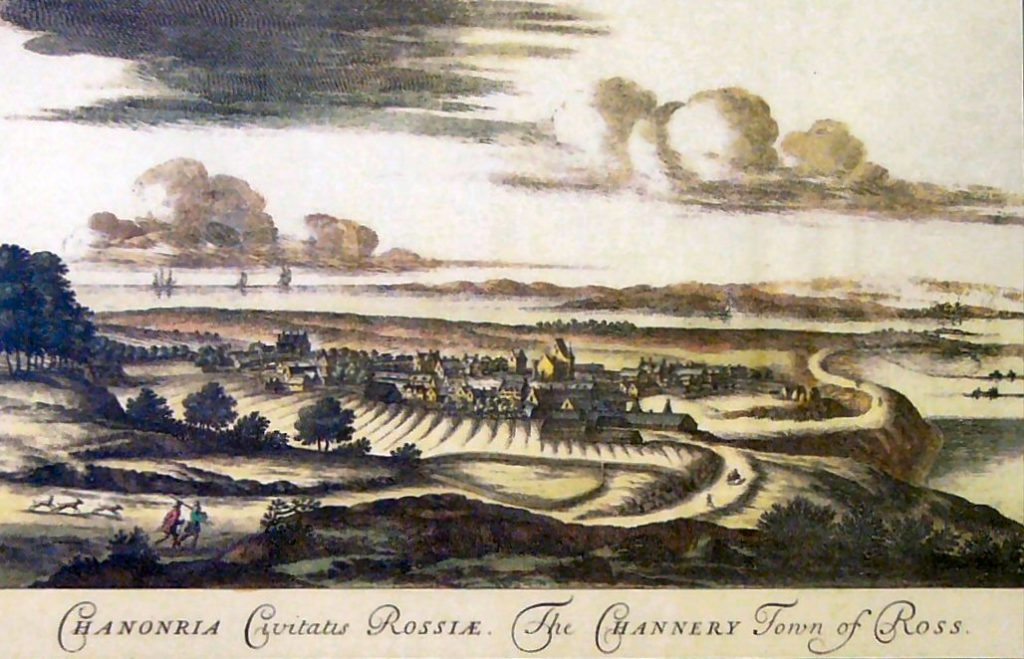Alongside fishing, farming has been one of the main industries of the area, and even today the annual competition between the fishers and farmers at the Avoch Gala is something to see.

The history of farming in the area goes back a long way – over 5000 years to be exact. Between 3000BC and 2000BC there was an increase in the number of Neolithic (New Stone Age) people in the Black Isle, which at that time was mainly covered with forests of oak, hazel and pine. In these roamed reindeer, elk, red deer and wild boar, which were hunted. Bear, lynx and wolf were also found there.

Of their timber and turf dwellings there are no traces but their massive stone tombs (above) are still found on the higher ground of the Black Isle.
Moving swiftly on by 5000 years or so…..
Harvest Raid at Avoch
From the Privy Council records of 1614:
“On 18th August 1614, Mr Johnne Mackenzie, Archdeacon of Ross and minister of Killearnan accompanied by fifty followers armed with “swordis, gauntlets, pistolettos etc” went before break of day to that part of Avach which marches with Arkindeath and reaped and carted away a quantity of bear (barley) spending three hours at the work.”

The Black Isle was a lawless area in the 16th and 17th centuries. As John Mackenzie was minister of Killearnan, this episode shows that the church was involved in the lawlessness. Mackenzie was fined £100 for this raid.
The picture (left) shows the remains of a small towerhouse at Arkendeith, dating from the 16th century. This small castle belonged to the Bruces.
Run Rig
All the cultivated land in the 1696 etching (below) of Fortrose shows the rigs of the “Run-rig” system of land use at that time.

The wide furrows between the rigs helped drainage but were covered with weeds or stones.
A number of different families (often related) worked the rigs, with each family’s rigs scattered over the farm. These families lived in a small settlement on the farm.
The tenancy of a rig often changed from year to year. The run-rig system went out of use with the great improvements in agriculture in the 18th and 19th centuries, but it survived in some Black Isle estates until the 1830s.
Farming in the 1920s

In the 1920s, a typical farm was between 100 and 200 acres and was a mixed arable farm with cattle, sheep, a few pigs and poultry.
On the livestock side, the emphasis was usually on beef cattle.
A dairy cow (Jersey or Ayrshire cross) was kept to provide the family with milk, which was also used to make butter or crowdie.
There were at least two Clydesdales for every 50 acres on the farm.
A six-year Norfolk rotation was carried out ie:
Grass > Grass > Oats > Potatoes > Turnips > Barley
The Black Isle was renowned for growing seed potatoes, especially Kerr’s Pink and Golden Wonder. In the other pages in this section see something of the farming heritage of the area, and something of the long-gone tools and methods.

The Terms
Whitsunday – May 28th ………. Martinmas – November 28th
Up to the 1930s, these were important dates in the farming calendar, especially 28th May. The farmer’s bills had to be settled by then, but the main significance of these dates was that these were the times when the farm servants could leave and move to a new farm.
A deal may have been quietly arranged beforehand, but any local farm servant wanting a change and who had not found a situation, or any farmer wanting to hire, would make his way to Inglis Street in Inverness (shown left) on a day shortly before the Term, when a feeling market was held.

The expert ploughman and the good employer did not have to wait long. The acceptance of five to ten shillings by the farm worker made the contract binding.
A flitting of his furniture and family on one or two overloaded carts drawn by Clydesdales from the new farm soon took place.
